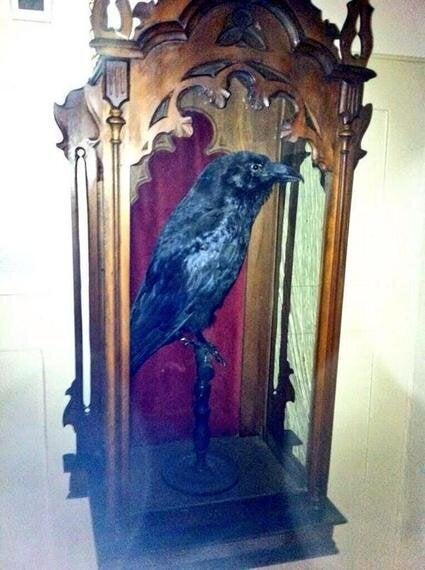The Tower of London may now, at least tentatively, count among its treasures an iconic raven that inspired Charles Dickens. It is stuffed and stands on a perch in a finely carved wooden case with glass walls and a silver base bearing the puzzling words: "Black Jack, whose death was occasioned by the fearful sound of cannon upon the funeral of H. G. (His Grace) the Duke of Wellington, late Constable of the Tower of London, anno 1852." There is a touch of irony in the inscription, since ravens are known for terrifying people, as in Poe's poem "The Raven," but here it is the other way around.
Poe is continually depicted with a raven as a companion, but perhaps he appropriated that image from Dickens. Unlike the English novelist, Poe did not keep ravens or show any particular fondness for them, and he had originally intended the bird in his poem to be a parrot. Dickens kept ravens for much of his life, and many visitors to his home including the writers Henry Wadsworth Longfellow and Hans Christian Andersen remarked on how a raven was constantly croaking in the background.
Ravenmaster Chris Skaife looks after the ravens at the Tower of London, which people say are the protectors of Britain. In January of 2014, he posted a picture of Black Jack on Twitter. I immediately had a hunch that Black Jack might have been a raven owned by Dickens, and became involved in a virtual conversation with the Ravenmaster and London historian Hannah Velten about his provenance.
Dickens' first raven, the inspiration for the raven Grip in his novel Barnaby Rudge, was also taken to a taxidermist after death, and is now the mascot of the Philadelphia Free Library. In a letter to Charles Maclise, dated March 12, 1841, Dickens writes movingly of Grip's last days and tells how he had the body autopsied prior to sending it for taxidermy, because he suspected his pet had been poisoned.
I contacted the library to ask about Grip's taxidermist, in the hope that this might provide a clue as to the identity of Black Jack. The librarian, Joseph Shemtov, graciously showed me a page from the logbook of taxidermist James Nutcher Bennett for part of the year 1852. Though it did not mention either Grip or Black Jack, the ledger contained a large order by Dickens for birds, confirming that Dickens was a good customer for taxidermy at the time.
I passed on the information to Ravenmaster Chris Skaife, who then took Black Jack to the Charles Dickens Museum in London. Though the personnel there were not able to specifically identify Black Jack, they did confirm that Dickens had at least four ravens in the course of his career, including one that died in 1852, the year of Wellington's Funeral at Saint Paul's Cathedral in London. In addition, Dickens had known Wellington personally and had attended his funeral as a prominent dignitary.
In a few short stories written over the previous two years and published in the magazine Household Words, Dickens had used a raven, presumably Black Jack, as a mouthpiece. The texts could well have been intended as a prelude to a longer work, which Dickens never got around to writing. In "Perfect Felicity" and "The Raven in the Happy Family I," the bird complains about being misrepresented by people, and plans to put together an anthology in which other animals such as the dog and horse will write down their impressions of human beings.
In "The Raven in the Happy Family II," the raven laughs at exploitive human funeral practices: "'Performing' funerals, indeed! I have heard of performing dogs and cats, performing goats and monkeys, performing ponies, white-mice, and canary-birds; but, performing drunkards at so much a day, guzzling over your dead, and throwing half of you into debt for a twelvemonth, beats all I ever heard of. Ha, ha!" Nevertheless, the raven defends the Undertaker, who the bird views as kindred spirit. The mortician is called the "Black Jobsman," a name that resembles "Black Jack."
Finally, in "The Raven in the Happy Family III," the narrator quotes at length from the first entry in his handbook on human beings, written by a horse who complains of human arrogance and dishonesty. The series might have continued with accounts by other animals such as a cat or cow, but they stop a bit before the time of Wellington's funeral.
To summarize so far, many features argue that the Tower's Black Jack was originally a raven in the Dickens household: The date of death, the carefully noted cause of death, the ironic tone of the inscription, and the use of taxidermy all point to that conclusion. Furthermore, if the effigy had not been associated with an illustrious name, it probably would not have wound up in the Tower of London at all. The inscription may be a sort of end to the truncated work of literature that Dickens had begun to center on Black Jack. A professional examination of Black Jack's taxidermy and case might be able to further confirm whether he was a companion to Dickens.
The first known references to ravens in the Tower of London date from 1883, considerably after Wellington's funeral . Just how the ravens were brought in to the Tower of London is not certain, but the Dickens' precedent for keeping ravens was probably a factor, especially if the Yeoman Warders of the late Victorian era were familiar with Black Jack and his history.
At least up until World War II, visitors usually viewed the ravens in the Tower of London one-dimensionally as figures of Gothic horror. Today, however, they have many roles including objects of scientific study, national pets and avatars of the natural world. Dickens wrote of ravens in several facets, and so his legacy is far more relevant than Poe's.

Black Jack
